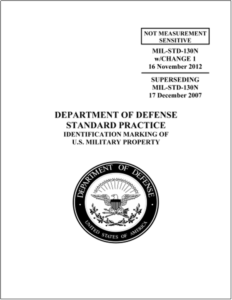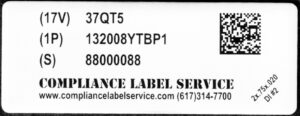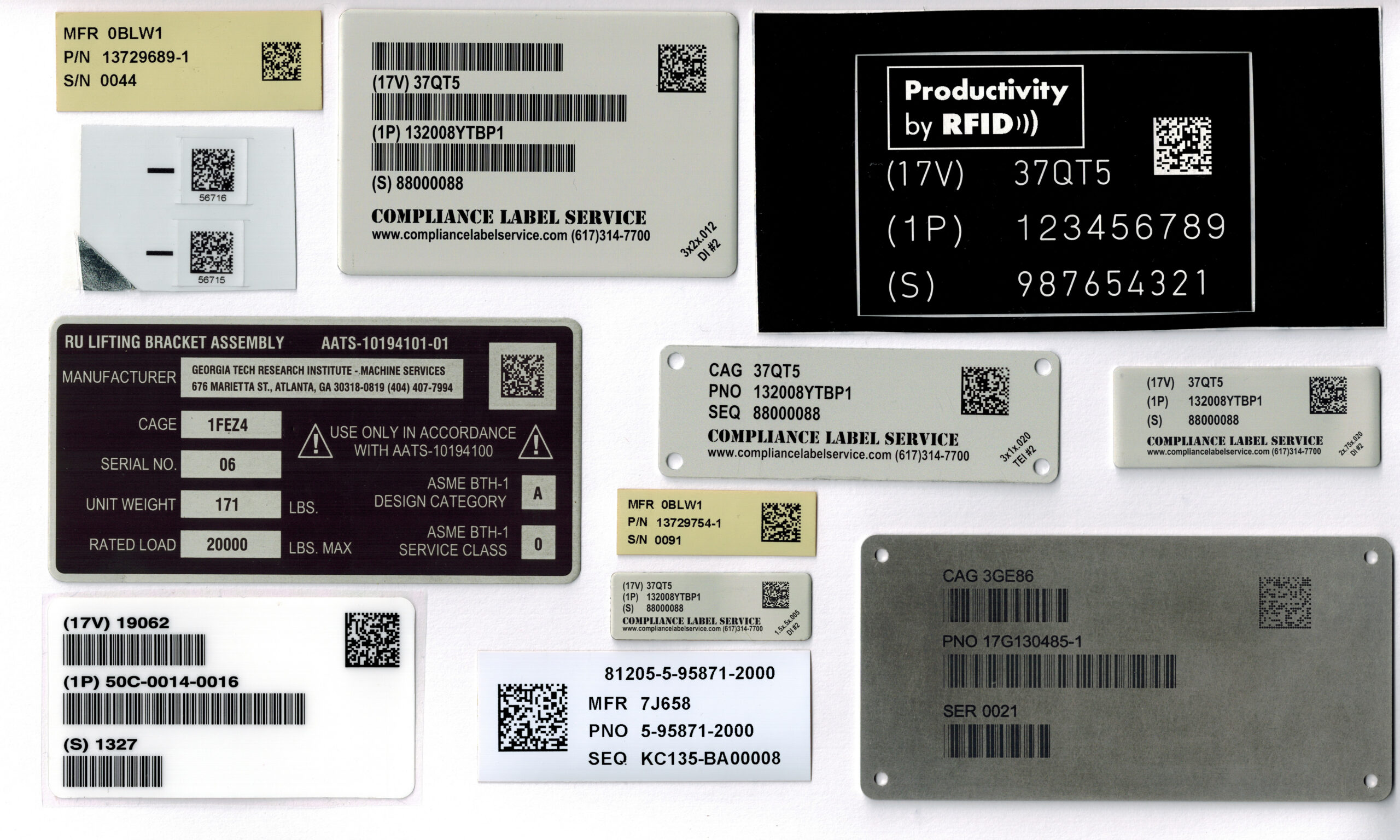MIL-STD-130 DOCUMENTS & RESOURCES
- Mil-Std-130N With Change 1: Identification Marking Of Us Military Property
- Mil-Prf-61002B: Pressure-Sensitive Adhesive Labels For Bar Coding
- Mil-Dtl-19834C: Plates, Identification Or Instruction, Metal Foil, Adhesive Backed General Specification For
- Mil-Dtl-15024G: Plates And Tags For Identification Of Equipment, General Specification For


FREQUENTLY ASKED QUESTIONS: MIL-STD-130
Which of my items require UID and which don’t?
MIL-STD-130 requires UID for all contract items which:
- Have a unit acquisition cost of $5,000 or greater (or are leased assets of any value)
- Are sensitive or classified, mission essential or controlled inventory
- Are serially managed by DoD
- Are furnished to others (Government Furnished Property, GFP)
“Mark in accordance with MIL-STD-130” or similar language may be included in your contract. However, UID is not required unless the items of the contract fit the categories listed above or the contract language explicitly requires UID.
How is the acquisition cost of an item valued? (From the Website of the UID Program Office)
It is the policy of the Department of Defense that Contractors shall be required to identify the Government’s unit acquisition cost (as defined in DFARS 252.211-7003(a)) for all items delivered even if none of the criteria for placing a IUID mark applies.
- For fixed price type line, subline, or exhibit line items, the unit acquisition cost is the unit price identified in the contract at the time of delivery.
- For cost type contracts line, subline, or exhibit line items, the unit acquisition cost is the contractor’s estimated fully burdened unit cost to the Government at the time the item is delivered.
- For items delivered under a time-and-materials contract, the unit acquisition cost is the contractor’s estimated fully burdened unit cost to the Government at the time of delivery.
The Government’s unit acquisition cost of subassemblies, components, and parts embedded in delivered items need not be [separately] identified.
An end item may be composed of embedded items, such as subassemblies, components and parts. The prime contractor will pass down appropriate specifications, including the IUID marking requirements, to the tiered vendors for subcontracted subassemblies, components and parts.
Spares may be purchased directly from the vendors or through the prime. IUID-qualifying spare items (subassemblies, components and parts) have to be marked appropriately with the IUID data elements. So, when the prime delivers the end item-that is one UII. The spares are delivered with their own UIIs. The Government has the option of asking the prime to deliver a list of all UIIs for IUID-qualifying embedded items in the end item.
What should be considered prior to creating a UID Tag?
MIL-STD-130 requires UID labels to last for the life of the asset, so you want to pick the least expensive, best-performing material to suit the conditions your asset sees. Compliance Label Service custom designs UID tags and offers a multitude of options for material, size, shape, and fastening methods. Our customers have the benefit of our expert knowledge of MIL-STD-130 and of the manufacturing process to be able to recommend the best type of marking for the supply – plate, band, tag or label. In collaboration with our customer we take into consideration the following:
- Environment in which the supply will live (ex. water, sunlight, temperature, etc.)
- Impacts or abrasions the UID marking must endure in its lifetime with use and cleaning
- Space available to determine the size of UID marking
- Material of the supply to which the UID marking must adhere
- Shape of the supply to which the UID marking must adhere (ex. flat or curved)
- Thickness of the marking material which best suits the supply
- Fastening Method (ex. adhesive, screws, rivets, sewn in, etc.)
- Additional data to be included, if any
Whose CAGE should be used for that element of the UID number?
The Department of Defense is most concerned with the Uniqueness of the data string and prefers the CAGE of the entity that is certifying that the UII data string uniquely describes one item only.
What are UID acceptable characters for Part Numbers and Serial Numbers?
- Capital letters ‘A’ to ‘Z’
- Numbers ‘0’ to ‘9’
- Special Characters: Hyphens ‘-‘ and Forward slashes ‘/’
- Not Acceptable: spaces or any other special characters
- 25 character maximum UID PN
- 25 character maximum UID SN
What are UID Tag material options?
Compliance Label Service supplies UID labels in the following materials:
- Polyester
- Metalized Polyester
- tesa® Secure™
- Polyimide (aka Kapton)
- Photo Anodized Aluminum
- Stainless Steel
- Titanium

If you have a different requirement, let us know!
How do I register the UID of my items?
There are two ways to register UID numbers. The first is to manually input UID data at WAWF when creating your shipment’s Receiving Report. There are several screens of input for each item. When your Government QAR signs off on the shipment in WAWF, the UID data flows automatically from WAWF into the IUID Registry. The IUID Registry is the ultimate repository of all UID data. As of mid-2009, WAWF was given capability to accept UID numbers and up to 50 UID ‘children’ for sub-components or subsystems. Additional UID ‘children’ or legacy items assigned UID’s must be input directly to the IUID Registry.
The second way is to directly input the data at the IUID Registry. This can be done via Secure File Transfer Protocol (SFTP) or Electronic Data Transfer (EDI). Only Government Furnished Property or Embedded item (i.e. ‘children’) can be manually input at the IUID Registry.
The prime contractor (i.e. the supplier selling directly to the government) is responsible for registering UID numbers. The prime may, of course, subcontract this responsibility.
We can help with registering UID’s! See IUID Registry Submission
